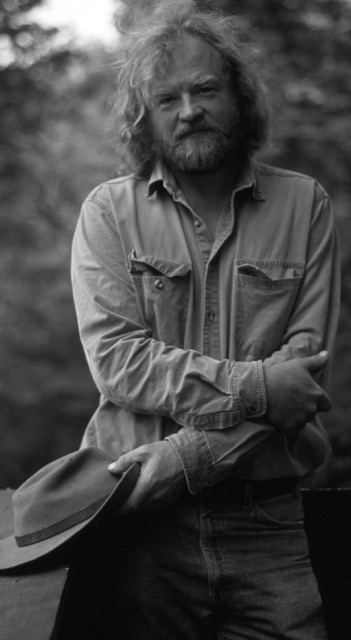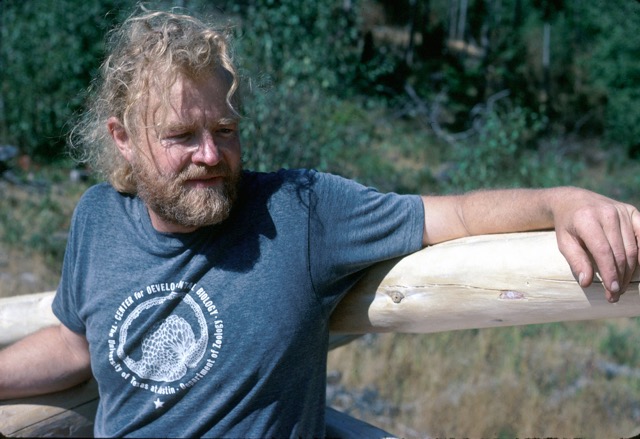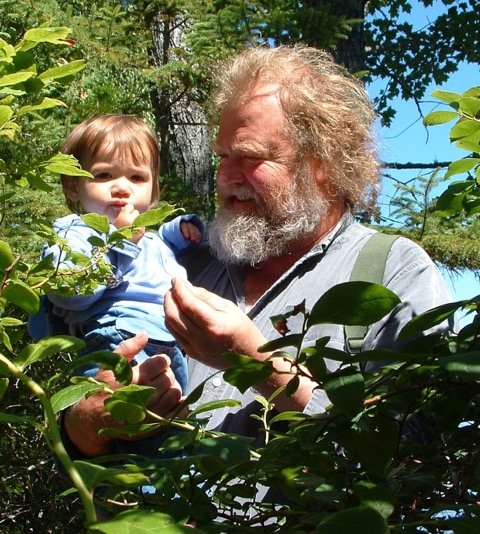


|
Garrett Mitchell Odell (4 April 1943 - 10 May 2018) |
written by George von Dassow.
On May 10, 2018 my mentor and friend Garry Odell died after a
half-year struggle to slow an advancing liver cancer just long enough
for those closest to him to get used to his unavoidable departure. In
a remarkable life - although it surely must have contained sadness and
frustration and disappointment too, as all lives must - Garry was to
so many students, colleagues, and friends the very most alive, lucent,
and fascinated being we have known. He embodied the atheist's faith
that intelligent life is the device by which the Universe knows
itself, and when he left us, we abruptly knew ourselves a little less
well.
Over four decades, Garry's published works were
perhaps few, but all deeply insightful. Many became profoundly
influential to cell and developmental biology and to ecology. The
first paper of Garry's that I read was co-written with Bruce Edgar,
when Bruce was a graduate student with Gerold Schubiger and Garry had
newly moved to the University of Washington's Zoology department. Only
a few years into the dawn of modern developmental genetics, Bruce and
Garry expressed a vision of regulatory gene function that eventually
became mainstream: instead of branching cascades or Turing mechanisms,
they offered an experiementally-grounded dynamical system accounting
for amplification of coarsely-specified patterns into sharp, stable
domains (1). This early, simple model described mutual
cross-regulation between genes whose products compete, nucleus by
nucleus within a shared cytoplasm, to define cell state and hence one
aspect of a regular coordinate system in the fly embryo. Expressed in
straightforward differential equations using terms familiar to anyone
with a passing exposure to biochemical kinetics, this vision of gene
networks as entangled circuit elements slowly became second nature in
modern molecular biology. When I found their paper I was working on
mesoderm induction in frog embryos, and it was just the point in
history where all of us in developmental biology were finding
ourselves with just enough genes and signals active in the same place
at the same time, that the sequential cascades began to curve into
networks that abruptly came to defy human intuition. As Garry might
have said, modeling gene networks as dynamical systems may have flaws,
but it's a big step up from a word-salad. The next of Garry's papers
I came across was a collaboration with Charles Peskin and George Oster
to theoretically substantiate the Brownian ratchet as a general means
by which living matter might harvest thermal energy to accomplish
directed motion (2).
As the authors pointed out, the notion of molecular motors as thermal
ratchets had been in the air for a long time, at least since Huxley.
Likewise the claim that polymerization alone, without a motor, could
push sufficiently to deform cell surfaces or propel loads; or even
that binding could do the equivalent kind of work. The value to modern
cell biology of this step – transforming the Brownian ratchet from a
straw man with the vague odor of sleight-of-hand, to a credible
hypothesis specific enough to relate to real data – would be hard to
overstate. As Peskin et al. explained, if polymerization of a single
filament could push, polymerization of several together could push
more, and account not just for filopodia and acrosomes but the
intracellular pathogen Listeria and, by extension, the lamellipod as
well; or for any number of analogous circumstances from kinetochores
to protein channels to membrane vesicle formation and on and on.
The paper of Garry's that I've read most recently was his 30-year-old
work with Peter Karieva deriving, from biologically-measurable traits,
a model for "preytaxis" by swarms of predators (3). In an
experimentally-tractable simple ecosystem (goldenrod, aphids, and
ladybugs) that could be rendered nearly one-dimensional, they showed
that a simple set of rules – principally, that ladybugs go straight
but turn more frequently in proportion to their satiation – explains
how, even without the means to detect prey from afar (let alone
measure a gradient of prey), predators congregate where prey density
is greatest. Moreover, this model accounts for the observed effect of
predator congregation in suppressing further prey outbreaks within a
neighborhood – that is, the ladybug-aphid system shares an essential
similarity with classic activator-inhibitor models of pattern
formation. The paper has two incidental aspects worth noting. First,
it is so clearly and considerately explained that it is practically a
tutorial. Second, it turns out to predict real-world outcomes that
all gardeners should note: don't heed the standard advice of master
gardeners everywhere to pull that one aphid-infested Fava plant,
because the Karieva/Odell model shows that this apparent pest source
actually sustains effective control.
These highlights might
surprise readers more familiar with Garry's touchstone collaborations
with George Oster and company on morphogenesis, his later papers with
me, Eli Meir, and others on genetic networks, or his work with
Victoria Foe, Ed Munro, Jon Alberts and others on cytoskeletal
mechanics in cells and embryos. Garry was as generous with his time
and talents – from mathematics to just plain figuring out how to do
things – as he was eagerly curious, and his unpublished contributions
to the work of numerous students and colleagues vastly outweigh the
visible products he left behind.
By analogy to the Erdös number, I suggest mathematical biologists devise an Odell number: to suitably measure his influence, it would have to be a complex number, the real part reflecting works that made it into print (with or without his name on them) and the imaginary part reflecting those many efforts which engaged his and others' sustained effort deeply enough to have shaped their world-view, even if somehow no one ever got around to writing a paper about it. Furthermore, reflecting Garry's deep commitments to physical realism, each component would increase not by mere increment but through a saturating response like n/(1+n), and collaborative distance would be modeled by diffusion. Like many of Garry's models, armed with a suitable recipe for the Odell number it would be difficult to intuit the outcome from the start but the ingredients would make mechanistic sense.
What motivated Garry Odell throughout his scientific work is stated most clearly and directly in one of the few papers he ever wrote alone, which describes a cytogel model of shuttle streaming in the plasmodial slime mold Physarum (4). This paper puzzles me greatly because, having co-written several manuscripts with Garry, at least a couple of which were never published, and having closely witnessed the fates of many others, I know well the kinds of barriers that reviewers and editors tended to erect, seemingly instinctively, to defend posterity against Garry's writing. I don't know the history of the Physarum paper, but because those who knew him can so clearly hear Garry's living voice rising from the page, I cannot help but assume its publication transpired from a complete collapse of the usual editorial process. I can do no better than quote from it directly:
"Intuitive discussions, however compelling the prose... are flimsy and should never be taken seriously unless rigorous mathematical solutions have actually been computed. The kind of verbal reasoning given [here] to explain why the system oscillates could be subverted to explain instead why oscillations are impossible. The mathematical model presented in this paper comprises a dynamical system, i.e. a system of differential equations asserting that the time rate of change of the state of the system is a function of the present state of the system ....[this kind of model] has a (stubborn) mind of its own and cannot be made to conform to prose forecasts of its behavior or the most fervent hopes of its inventors. This perverse feature, at least, dynamical system models share with biological cells."
And a little further on:
"The quest is to understand the self organization process by which myriad identical proteins, transcribed directly from genetic sequence code, interact with each other to ignite an upward spiral of complexity amplification. Even very simple interaction rules iterated by many sub-units of an organism (for example cells, proteins or organelles), can produce collective results of astonishing complexity. Mathematics [is] a language invented to facilitate the precise expression of such rules, together with the logical deduction of their consequences. In the quest to understand the dynamics of development, mathematics as a language is much more potent than ordinary language."
Decades before there were departments of "Systems Biology", these passages foresee and succinctly express both premise and promise of a field that he showed the way into.
Garry's early work relied (necessarily) on relatively simple models and, where possible, matched analytical to numerical solutions. By the time I knew him, however, he was ambivalent about similar efforts and urged his students to eschew elegance and intuitive simplification while seeking a workable balance between realism and computational tractability. A native computer programmer who could proceed smoothly from emitting English to spoken C from either the front of a classroom or a log on the beach, Garry eagerly embraced Java and object-oriented programming when it came along and thereafter focused himself on crafting individual-based simulations as the apotheosis of the vision expressed in the excerpts above.
That approach emphatically does not mean giving up hope of results that appeal to human intuition: on the contrary, Garry eagerly watched the simulations he crafted–
for example, of microtubules and motors (5) – as keenly as any ethologist, and experimented on them to infer their intrinsic causes. He met with true and eager delight the never-ending stream of emergent rebuttals to his own or others' predictions, and even the mundane challenges that arose as models took shape. This feeling was inarguably one with his own gladness to be alive and conscious. Take as a closing thought his reaction to the tricky challenge of figuring out, in code, if and when two virtual objects collide in a three-dimensional space: "just another one of the terrific things we get for free, just by being real!"
Works discussed here:
1. Edgar, B. A., Odell, G. M., & Schubiger, G. (1989). A genetic switch, based on negative regulation, sharpens stripes in Drosophila embryo\
s. genesis, 10(3), 124-142.
2. Peskin, C. S., Odell, G. M., & Oster, G. F. (1993). Cellular motions and thermal fluctuations: the Brownian ratchet. Biophysical journal,\
65(1), 316-324.
3. Kareiva, P., & Odell, G. (1987). Swarms of predators exhibit" preytaxis" if individual predators use area-restricted search. The American\
Naturalist, 130(2), 233-270.
4. Odell, G. M. (1984). A mathematically modelled cytogel cortex exhibits periodic Ca++-modulated contraction cycles seen in Physarum shuttl\
e streaming. Development, 83(Supplement), 261-287.
5. Odell, G. M., & Foe, V. E. (2008). An agent-based model contrasts opposite effects of dynamic and stable microtubules on cleavage furrow \
positioning. The Journal of cell biology, 183(3), 471-483.
by Edwin Munro
(from Autumn 2018 issue of Intertidal Tidings vol 39: p 6)

Garry in homesteading mode, on Denman Island BC, where he build by hand a post and beam cabin. Photo: Victoria Foe summer 1992
Garry spent his childhood roaming the woods and fields of rural New Jersey, suburban Connecticut and northern Maine. He studied engineering and theoretical mechanics at Johns Hopkins. Fortuitous advice from a fellow graduate student steered him into mathematical biology. As a rising professor in the Department of Mathematical Sciences at the Rensselaer Polytechnic Institute, Garry published a series of seminal papers on intracellular contractility, the collective movements of chemotactic cells, and the cellular mechanics of tissue morphogenesis. These papers captured what was then a pioneering vision of how mathematical models, grounded in a physical view of living matter, could reveal deep insights into complex emergent biological dynamics. Many were written with leading experimental biologists of the time, and central to his vision was a need to work closely with biologists so that models could inform and be informed by observation and experiment. And so, in 1986, Garry took the remarkable step of moving to the UW Zoology department.
Over the next several decades, Garry became a deeply embeded and highly cherished member of UW Zoology. He served as an intellectual analog of the mathematician's spherical cow – consuming biological facts at a constant rate, and radiating mathematical theory, physical and biological insight with equal velocity in all directions. Through his legendary Berlitz language course in applied mathematics, he inspired several generations of students and postdocs to learn the art of mathematical modeling. One of these students was a brilliant young biologist name George von Dassow, whom Garry inspired to model the Drosphillia segment polarity gene network as an example of a robust developmental module. George entrained his fellow students (Eli Meir and I), and Garry served as coach and cheerleader. The resulting paper by von Dassow et al became an almost instant classic and served as one of essential catalysts for founding (and funding) the Center for Cell Dynamics (CCD) at FHL, with Garry Odell as director.
By nature, Garry was disinclined to direct anything. Instead, he was the CCD's animating spirit, and the CCD expressed (imperfectly) his scientific vision of a community without disciplinary boundaries or hierarchy or adult supervision, in which biologists, mathematicians and computer scientists worked together as coequal partners. It also expressed a vision, shared by Garry and Vic and the rest of us, in which science and life and love and art and food and music blended continuously together. It was of course no accident to found the CCD at FHL. The FHL was and remains a shining example of the kind of human-scale scientific community for which Garry yearned and to which the CCD aspired. It was among the places that first drew Garry to the Pacific Northwest. It is where he and Victoria first met and fell in love, and it was for him, a chance to return to a way of life that he imprinted on as a young boy in the wilds of northern Maine.
For those who did not know Garry, it is almost impossible to describe what it was like to live and work and learn with him. He was probably the most brilliant person that any of us have ever known. But through that brilliance shone an intensely human, loving, and radiantly joyful spirit that animated everything he said and did. To Garry, life was an endlessly entertaining game to discover how things work. It was a game at which he excelled, and over a lifetime of play, he had acquired what seemed to be an inexhaustible supply of knowledge concerning almost anything worth knowing. He had a remarkable ability to merge effortlessly a theoretical understanding of why things work with a practical understanding of how to make things that work. There was almost no topic concerning how things work in the natural world on which he could not (and did not) deliver a lecture at moments notice; there seemed to be no device, whose working depended on such knowledge, that he could not build in an afternoon from found parts. We used to say (only half-joking) that Garry was the one person you wanted in your camp in a post-apocalyptic world.
Garry was also an extraordinarily gifted mentor and teacher. For him teaching was a biological imperative – an ancient form of human reproduction that pushed knowledge forward through successive generations. Garry's approach was simple and applied equally to students of all ages, from young children on up – he treated us like a younger, less experienced version of himself. He saw in our experience an echo of his own, and in doing so, called forth from us a reflection of his own brilliance and his own joyful intensity. It was an almost entirely selfless act, performed without expectation of material reward or return. For me it is perhaps the most loving act I have ever experienced from another human.
Garry is survived by his beloved wife Victoria Foe, his two siblings, his two sons and four grand daughters. He is also survived by the many hundreds of people with whom he played and taught and by the treasure trove of ideas that he unearthed and shared with all of us and that will slowly make their way through our generation and the next, and the next, until long after all of us are gone.

Garry picking blueberries with his granddaughter Aiko at Meddybemps Lake, in Maine 2004. Photo: Elayne Takemoto